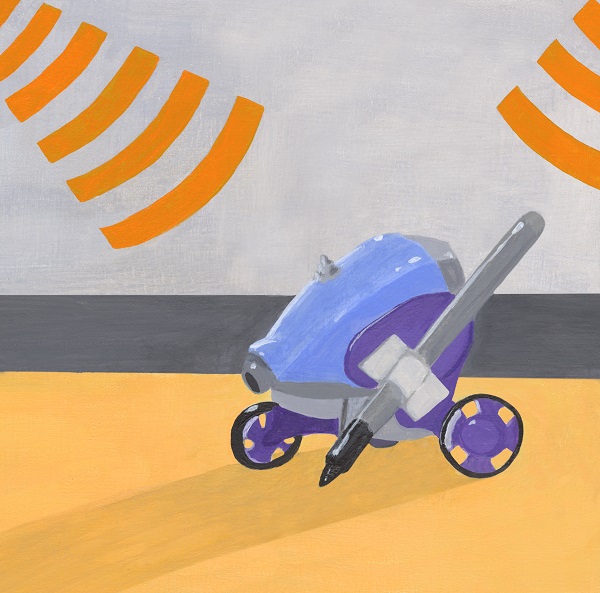GL.TCH Science, GL.TCH Art: Peter Foucault’s Attraction/Repulsion
Illustrated by Jafer Wong
A GL.TCH that has interested me recently is the drawing installation Attraction/Repulsion by the artist Peter Foucault. In the piece, a marker is attached to a small robot, which in turn is put on a piece of paper. The movements of the robot are then dictated by audio inputs from microphones the audience is  allowed to use. So, large, intricate drawings are made through the spontaneity of the onlookers. Most of the pieces end up looking very similar, but none are identical, as the sounds made by each crowd are always different. Presumably, if one were to set up two sessions in which the sequence of sounds is identical, except for at a few points, the two drawings might very well end up dramatically different, just due to the robot’s changes in course. Different programs could also be used to have the input be, instead of sound, a written piece or even a visual input, like another drawing.
allowed to use. So, large, intricate drawings are made through the spontaneity of the onlookers. Most of the pieces end up looking very similar, but none are identical, as the sounds made by each crowd are always different. Presumably, if one were to set up two sessions in which the sequence of sounds is identical, except for at a few points, the two drawings might very well end up dramatically different, just due to the robot’s changes in course. Different programs could also be used to have the input be, instead of sound, a written piece or even a visual input, like another drawing.
The reason I find this GL.TCH so interesting is that it makes it possible to create beautifully intricate drawings through pure spontaneity. It brings attention to how the random sensory inputs we take for granted in everyday life are unique and every particular sequence is different. In this case it was sound, but one can extend it to include, in terms of senses, colour, form, feelings, tastes, and smells. Outside of simple sensory inputs, sequences of numbers, letters, and words could be added to the list. All these things, when taken in sequence, can be converted into unique works of art through some sort of process (in this particular case, a programed robot.) But even the process could be played with, creating a wealth of possibilities when it comes to artistic experiments like this.
Video of the Installation:
https://vimeo.com/87782701

Comments
No comments posted yet.
You have to be registered and logged in in order to post comments!